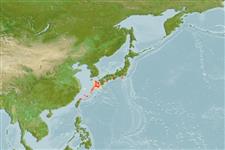Environment: milieu / climate zone / depth range / distribution range
Ecology
Marine; bathydemersal; non-migratory; depth range 250 - 790 m (Ref. 1371). Deep-water; 35°N - 24°N, 121°E - 140°E (Ref. 1371)
Northwest Pacific: southern Japan to the East China Sea.
Size / Weight / Age
Maturity: Lm ? range ? - ? cm
Max length : 62.0 cm TL male/unsexed; (Ref. 1371)
Dorsal spines (total): 2; Anal spines: 0. Head almost completely scaled, except for the underside of the snout and anteriorly on the mandibular rami. Snout short, pointed, with stout conical tubercle at its tip and lateral angles; suborbital ridge prominent; mouth small; chin barbel very small. Scales rather deciduous; body scales with slender spinules in 7 to 19 parallel rows. Pyloric caeca 11 to 14, about half of orbit diameter, directed anteriorly. Overall color is purplish brown, lighter ventrally on head and trunk; oral and branchial cavities blackish; fins blackish.
Benthopelagic in sandy mud bottoms (Ref. 1371).
Life cycle and mating behavior
Maturity | Reproduction | Spawning | Eggs | Fecundity | Larvae
Cohen, D.M., T. Inada, T. Iwamoto and N. Scialabba, 1990. FAO species catalogue. Vol. 10. Gadiform fishes of the world (Order Gadiformes). An annotated and illustrated catalogue of cods, hakes, grenadiers and other gadiform fishes known to date. FAO Fish. Synop. 125(10). Rome: FAO. 442 p. (Ref. 1371)
IUCN Red List Status (Ref. 130435: Version 2024-2)
Threat to humans
Harmless
Human uses
Fisheries: minor commercial
Tools
Special reports
Download XML
Internet sources
Estimates based on models
Preferred temperature (Ref.
123201): 7.4 - 16.2, mean 12.9 °C (based on 27 cells).
Phylogenetic diversity index (Ref.
82804): PD
50 = 0.5000 [Uniqueness, from 0.5 = low to 2.0 = high].
Bayesian length-weight: a=0.00214 (0.00109 - 0.00421), b=3.20 (3.03 - 3.37), in cm total length, based on LWR estimates for this (Sub)family-body shape (Ref.
93245).
Trophic level (Ref.
69278): 3.6 ±0.4 se; based on size and trophs of closest relatives
Resilience (Ref.
120179): Very Low, minimum population doubling time more than 14 years (Preliminary K or Fecundity.).
Fishing Vulnerability (Ref.
59153): Moderate vulnerability (45 of 100).
